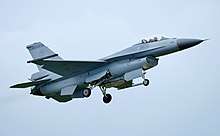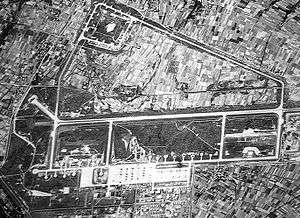Ching Chuan Kang Air Base
Ching Chuan Kang Air Base (Taiwanese Mandarin:清泉崗空軍基地, CCK) is a Republic of China Air Force (ROCAF) base located in Taichung, Taiwan. It is the home to the 3rd Tactical Fighter Wing, with three squadrons of AIDC F-CK-1 Ching-kuo air-defense /attack fighters. It is also used by the army's airborne and special operations command.

| Ching Chuan Kang Air Base 清泉崗空軍基地 | |
|---|---|
  | |
| Part of Republic of China Air Force | |
| Located in Taichung, Republic of China (Taiwan) | |
 Unrectified aerial Image of CCK Air Base from the United States National Reconnaissance Office Corona Satellite | |
| Coordinates | 24.26°N 120.62°E |
| Type | Air Base |
| Site information | |
| Controlled by | |
| Site history | |
| Built | 1957 |
| Built by | |
| In use | 1957–present |
| Battles/wars | Vietnam War |





Ching Chuan Kang Air Base is shared with Taichung International Airport (IATA: RMQ, ICAO: RCMQ).
History
The forerunner to CCK Air Base was built in 1936, during Japanese rule, in the vicinity of Kōkan (Japanese: 公館), hence the former name Kōkan Airport. Construction of the airfield started in 1957, and was given the highest priority of several projects begun after the situation between Taiwan and Mainland China became tense in the mid-1950s. The air base was renamed Ching Chuan Kang Air Base on 20 March 1966 in memory of ROC Army Gen. Qiu Qingquan, and was thereafter known throughout the theater by its initials, CCK. As of the late 1990s, the longest runway at CCK was reportedly 12,000 feet (3,700 m) long.
Taiwan obtained an initial batch of American F-104 Starfighters in 1960–61, and eventually received over 200 of these aircraft, all of which were withdrawn from service in the early 1990s. The Starfighters were operated by the 2nd/499th Tactical Fighter Wing at Hsinchu, the 3rd/427th TFW at Ching Chuan Kang AB, and the 5th/401st Tactical Combined Wing at Taoyuan.
In May 1999 it was reported that China had built a replica of Ching Chuan Kang AB at a site near Dingxin airport (40.379°N 99.89°E) in the northwest province of Gansu, presumably to train units assigned to attack the Taiwanese facility in the event of conflict.[1]
The base is also currently home to the AH-1W attack helicopters of the Army’s 602nd Brigade.[2]
USAF use
During the Cold War, CCK was used by the United States Air Force as a support installation of United States Taiwan Defense Command. At the same time, it is also the largest air base of the US military stationed in Taiwan, with about 4,000-5,000 US troops stationed.
USAF use of the base began in 1958 with the deployment of twelve Lockheed F-104 Starfighters from the 83rd Fighter Interceptor Squadron during the Quemoy crisis. The crisis was peacefully resolved, and the aircraft were returned to the United States.
In April 1965, the 479th Tactical Fighter Wing at George AFB California deployed two F-104C squadrons to CCK (434th and 435th TFS).
Tactical Air Command reassigned the 314th Troop Carrier Wing, with Fairchild C-123 Providers and Lockheed C-130 Hercules to CCK on 22 January 1966 from Sewart AFB, Tennessee. Known squadrons were:
- 50th Tactical Airlift Squadron (C-130E) (February 1966 – May 1971) (Tail Code DE)
- 345th Tactical Airlift Squadron (C-130E) (February 1966 – May 1971) (Tail Code DH)
- 346th Tactical Airlift Squadron (C-130E) (March 1969 – May 1971) (Tail Code DY)
- 776th Tactical Airlift Squadron (C-130E) (February 1966 – May 1971) (Tail Code DL)
These aircraft remained deployed to the base to provide passenger and cargo airlift throughout the Far East and combat airlift in Southeast Asia. The 314th TAW returned to Little Rock AFB, Arkansas in 1971. The 314th was replaced by the Pacific Air Forces 374th Tactical Airlift Wing on 31 May 1971, being reassigned from Naha AB, Okinawa with CCK becoming a major depot support facility in Asia for theater-based tactical airlift aircraft. Known squadrons were:
- 21st Tactical Airlift Squadron (C-130E) (May 1971 – November 1973) (Tail Code DY)
- 50th Tactical Airlift Squadron (C-130E) (May 1971 – November 1973) (Tail Code DE)
- 345th Tactical Airlift Squadron (C-130E) (May 1971 – November 1973) (Tail Code DH)
- 776th Tactical Airlift Squadron (C-130E) (May 1971 – November 1973) (Tail Code DL)
The 374th remained heavily committed to support of operations in Southeast Asia, and also continued routine airlift in other areas. One of the wing's humanitarian missions-flood relief in the Philippines-earned it a Philippine Republic Presidential Unit Citation in 1972. The wing provided support in March 1973 for Operation Homecoming, the repatriation of American prisoners from Hanoi, North Vietnam.
The increase in the B-52 Arc Light sortie rates over Vietnam necessitated relocation of additional KC-135's which provided PACAF fighter support. In February 1968 the United States Air Force Strategic Air Command 4220th Air Refueling Squadron deployed to CCK, bringing KC-135 tankers formerly based at Takhli RTAFB, Thailand and Kadena AB Okinawa.
The KC-135s were redeployed to permit increased B-52 operations at U-Tapao and F-111 deployment at Takhli. The move of the KC-135's to Ching Chuan Kang increased their effectiveness since they would be based nearer to Vietnam refueling areas. In addition five U-Tapao Royal Thai Navy Airfield based radio relay aircraft were moved to Ching Chuan Kang by February 1968, along with approximately 450 additional USAF personnel.
Two Martin EB-57 Canberras from the 347th Tactical Fighter Wing based at Yokota AB Japan deployed to CCK, between November 29 and December 8, 1968. These aircraft provided Republic of China Air Defense pilots an opportunity to detect and intercept enemy aircraft that used electronic countermeasure (ECM) equipment.
On 20 February 1972 a Lockheed HC-130 set a world record [that still stands] for a great circle distance without landing with a turboprop aircraft of 8,732.09 miles (14,052.94 km), flying from Ching Chuan Kang AB to Scott AFB, Illinois.
The 18th Tactical Fighter Wing based at Kadena AB, Okinawa maintained a detachment of McDonnell F-4C Phantom II aircraft from November 1972 until May 1975.
On 6 November, 1972, the 18th Wing dispatched the McDonnell Douglas F-4C/D Phantom II fighters of 44th Fighter Squadron and 67th Fighter Squadron to the Ching Chuan Kang Air Base in Taiwan until 31 May 1975, to assist Taiwan ’s air defense.
The following are the units that the 18th Tactical Fighter Wing once stationed at Ching Chuan Kang Air Base in Taiwan:
- 44th Fighter-Bomber Squadron (Tail Code: ZL) (6 November 1972 – 31 May, 1975) (F-4C/D)
- 67th Fighter-Bomber Squadron (Tail Code: ZG) (6 November 1972 – 31 July 1974) (EF-4C)
On 13 November 1973, the 374th TAW was reassigned to Clark AB Philippines. In April 1979, normalization of relations with the People's Republic of China (PRC) led to the withdrawal of USAF personnel from the base.
See also
References
- O'HARA, CAROLYN. "China builds a mock Taiwanese air base". foreignpolicy.com. Foreign Policy Magazine. Retrieved 2 February 2020.
- Jiawen, Cheng. "Qingquangang Mysterious Reconnaissance Aircraft". udn.com. United Daily News. Retrieved 2 February 2020.
![]()
- Martin, Patrick (1994). Tail Code: The Complete History of USAF Tactical Aircraft Tail Code Markings. Schiffer Military Aviation History. ISBN 0-88740-513-4.
- Ravenstein, Charles A. (1984). Air Force Combat Wings Lineage and Honors Histories 1947-1977. Maxwell AFB, Alabama: Office of Air Force History. ISBN 0-912799-12-9.
- USAAS-USAAC-USAAF-USAF Aircraft Serial Numbers—1908 to present
- GlobalSecurity.org Ching Chuan Kang Air Base
- Air Force Historical Research Agency
External links
| Wikimedia Commons has media related to Ching Chuang Kang Air Force Base. |
_Logo.svg.png)